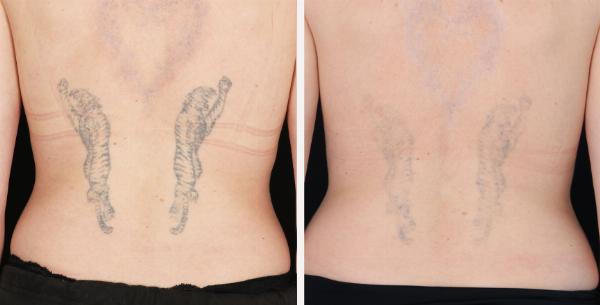Unleash Your True Canvas Laser Tattoo Removal

Introduction to Laser Tattoo Removal:
Tattoos, once considered permanent marks of self-expression, can now be safely and effectively removed thanks to advancements in laser technology. Whether it's a shift in personal taste, a professional requirement, or the desire to erase a painful memory, Laser Tattoo Removal in Dubai offers a reliable solution. This article delves into the intricacies of laser tattoo removal, its benefits, the process involved, and what you can expect from the treatment.
Understanding the Laser Tattoo Removal Process:
How Does Laser Tattoo Removal Work?
Laser tattoo removal employs high-intensity light beams to break down the ink particles embedded in the skin. These light beams target the pigment of the tattoo, causing it to fragment into smaller particles. Over time, the body's immune system absorbs and eliminates these fragmented particles, gradually fading the tattoo. Different types of lasers are used depending on the color of the tattoo ink, as different wavelengths of light are absorbed by different colors.
The Technology Behind It:
The most commonly used lasers in tattoo removal are Q-switched lasers, including the Q-switched Nd
, which is highly effective for dark inks such as black and blue, and the Q-switched ruby laser, which is better suited for green and blue inks. Picosecond lasers, a more recent innovation, deliver ultra-short pulses of energy, breaking down the ink particles more efficiently and requiring fewer sessions.
Benefits of Laser Tattoo Removal:
Precision and Safety:
Laser technology allows for precise targeting of tattoo ink, minimizing damage to the surrounding skin. This precision reduces the risk of scarring, making laser tattoo removal a safer alternative compared to older methods like dermabrasion or surgical excision.
Minimal Downtime:
One of the key advantages of laser tattoo removal is the minimal downtime associated with the procedure. Most patients can resume their daily activities immediately after treatment, with only mild redness and swelling that subsides within a few days.
Effective on All Skin Types:
Advancements in laser technology have made tattoo removal safe and effective for all skin types. Specialized lasers can be adjusted to accommodate different skin tones, ensuring that the treatment is both effective and safe for everyone.
What to Expect During the Procedure:
Initial Consultation:
The first step in the laser tattoo removal process is an initial consultation with a qualified dermatologist or laser technician. During this consultation, the professional will assess your tattoo, discuss your medical history, and determine the most appropriate treatment plan. Factors such as the age, size, and color of the tattoo, as well as your skin type, will influence the treatment approach.
The Treatment Sessions:
The number of sessions required for complete tattoo removal varies depending on several factors, including the tattoo's size, color, and age. On average, most tattoos require between 6 to 10 sessions spaced 6 to 8 weeks apart. Each session typically lasts between 10 to 30 minutes, depending on the size and complexity of the tattoo.
During the Session:
During the treatment session, the laser technician will apply a topical numbing cream to minimize discomfort. Patients often describe the sensation as similar to the snap of a rubber band against the skin. The laser will be passed over the tattoo, delivering pulses of light that break down the ink particles. Protective eyewear is worn to shield the eyes from the laser light.
Post-Treatment Care:
Immediate Aftercare:
After the procedure, the treated area may be red, swollen, and slightly blistered. Applying a cold compress can help reduce swelling and discomfort. It's important to keep the area clean and dry, avoiding any potential irritants such as lotions or creams that are not recommended by your dermatologist.
Long-Term Aftercare:
To ensure optimal results and prevent complications, follow your dermatologist's aftercare instructions meticulously. This may include avoiding sun exposure, refraining from picking at scabs or blisters and applying prescribed ointments to aid healing. The skin typically takes a few weeks to heal completely between sessions, during which time the tattoo will gradually fade.
Potential Side Effects and Risks:
While laser tattoo removal is generally safe, some potential side effects and risks include hyperpigmentation or hypopigmentation (darkening or lightening of the skin), scarring, and infection. Choosing a reputable clinic with experienced professionals can significantly reduce these risks.
Choosing the Right Clinic:
Research and Reviews:
When selecting a clinic for laser tattoo removal, it's crucial to conduct thorough research. Look for clinics with positive reviews and testimonials from previous clients. Personal recommendations can also be invaluable in finding a trustworthy provider.
Qualifications and Experience:
Ensure that the clinic employs qualified dermatologists or certified laser technicians with extensive experience in tattoo removal. Proper credentials and training are indicators of professionalism and expertise.
Technology and Equipment:
Inquire about the type of laser equipment used by the clinic. State-of-the-art lasers, such as Q-switched and picosecond lasers, offer the best results with minimal side effects. A reputable clinic should invest in advanced technology to provide the safest and most effective treatments.
Conclusion:
Laser tattoo removal offers a safe, effective, and minimally invasive solution for those seeking to erase unwanted tattoos. With advancements in laser technology, the procedure has become more precise, reducing the risk of scarring and downtime. By choosing a reputable clinic and following the recommended aftercare, you can unleash your true canvas and enjoy clear, tattoo-free skin. Whether driven by personal or professional reasons, laser tattoo removal provides a second chance to redefine your body art and move forward with confidence.
Note: IndiBlogHub features both user-submitted and editorial content. We do not verify third-party contributions. Read our Disclaimer and Privacy Policyfor details.







